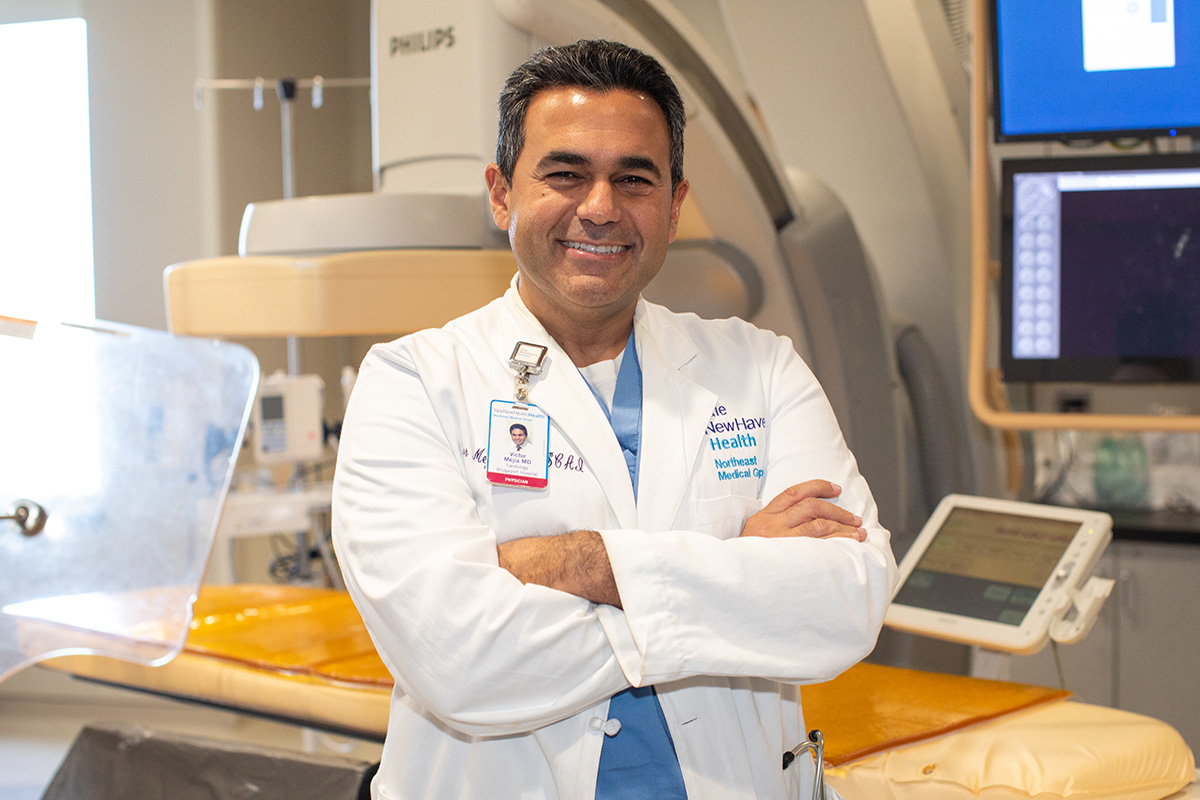
Popular Locations
- NEMG Internal Medicine - New Haven
- NEMG Internal Medicine - Orange
- NEMG Internal Medicine - Trumbull

Published April 03, 2023

Coronary artery disease (CAD) is a sneaky form of heart disease that can quietly develop over time and show up as a heart attack in the unsuspecting. Each year, hundreds of life-saving procedures for patients with CAD are performed by the experts at Bridgeport Hospital’s Heart and Vascular Center (HVC).
“About 20 million people in the United States over the age of 20 have coronary artery disease, and in 2020, more than 350,000 people died from it,” said Victor Mejia, MD, co-director of the cardiac catheterization laboratory at Bridgeport Hospital and a Northeast Medical Group interventional cardiologist. “You can think of a heart attack as the worst outcome of coronary artery disease.”
A heart attack occurs when blood flow to the heart is severely reduced or blocked – most commonly by a buildup of plaque, such as fatty tissue, cholesterol and calcium – in the coronary arteries. This accumulation of plaque is called atherosclerosis, which can cause narrowing of the arteries and restrict blood flow. If the plaque ruptures, a blood clot can form and cause a heart attack.
“In some people, the calcium can be quite extensive and can lead to very calcified plaque in the artery,” Dr. Mejia said. “That is something we see more often today than we did several years ago, and it is more challenging to treat.”
Cholesterol-lowering medications, such as statins, can help keep heart attacks at bay. “The statins are a crucial part of treatment because they have shown over decades to lower the risk of a heart attack,” Dr. Mejia said.
An acute heart attack is a medical emergency requiring prompt treatment. “When it is time to open up the artery in the setting of a heart attack – or when we’re trying to improve quality of life and symptoms when medicines have not done enough – we can turn to cardiac catheterization and angioplasty as options,” Dr. Mejia explained.
Cardiac catheterization is a diagnostic procedure in which a thin, flexible tube called a catheter is guided through a blood vessel to the heart. This allows physicians to diagnose and treat certain conditions, including blocked arteries. Angioplasty is often performed during a heart attack to quickly open a blocked artery to improve blood flow and reduce damage to the heart. During the procedure, a tiny balloon catheter is inserted into the blocked blood vessel to widen it, and a small wire mesh tube called a stent helps to keep the artery open.
“We also have the ability to treat more complex disease because of new equipment now available at Bridgeport Hospital,” Dr. Mejia added. “One new treatment option is the Shockwave Intravascular Lithotripsy System, which uses sonic pressure waves to break up calcified plaque.
“A rotational atherectomy device, which uses small blades to cut away plaque in a circular motion, and an orbital device that is used to grind plaque in a spinning motion, are among the advanced tools we offer to treat more severe calcified lesions,” he said.
Some patients with coronary artery disease may require a procedure called coronary artery bypass grafting (CABG), the most common open-heart surgery performed in the United States.

“Coronary artery bypass surgery is actually the most common operation that we do in cardiac surgery, and it’s quite well tolerated,” said Gabriele Di Luozzo, MD, associate professor of surgery (Cardiac), at Yale School of Medicine and section chief of Cardiac Surgery at Bridgeport Hospital’s HVC. “The operation lasts about four hours, and the patient stays in the hospital four or five days.
“Surgical bypass, or surgical revascularization, is indicated when a patient has two or three arteries that are blocked, and they are too complex to offer stenting; this includes patients with diabetes,” Dr. Di Luozzo explained. “Some patients who have a lower heart function may also benefit from bypass surgery, and it is preferred in those with significant blockage of the left main artery of the heart.”
In CABG surgery, a new pathway is created for blood to flow around a blocked or partially blocked artery in the heart using a new blood vessel (a graft) taken from another part of the body.
“Usually, you take veins from the patient’s legs, but we typically use arteries from the forearm or from both sides of the chest wall to do the bypasses,” Dr. Di Luozzo said. “We believe this offers a more durable outcome for the patient.”
A unique program now offered at Bridgeport Hospital is a robotic coronary artery bypass procedure for patients with complex blockages of the main artery of the heart – the left anterior descending artery.
“We use the da Vinci® robot to bypass that particular artery, offering a lot of benefit to the patient, specifically an increase in survival,” Dr. Di Luozzo said. “It’s minimally invasive – it’s not a big incision in one’s chest – and the recovery is quicker. There is less pain and a faster return to normal activities.”
When it comes to heart disease, prevention is the best medicine.
“The first role of any of this is a good diet and risk factor modification,” Dr. Di Luozzo said. “If you’re a smoker, stop smoking. If you’re not eating well, start eating well. These are some of the fundamentals for anyone with CAD.”
“I think it is important to highlight that more data are showing that being inactive is a risk factor for heart disease,” Dr. Mejia added. “People who exercise regularly and are more active are more protected against heart disease, in general, and coronary artery disease specifically.”
To learn more about risk factors and prevention, read the article His and Her Heart Attacks: Know the Signs.
Sign up to receive valuable information about heart health.